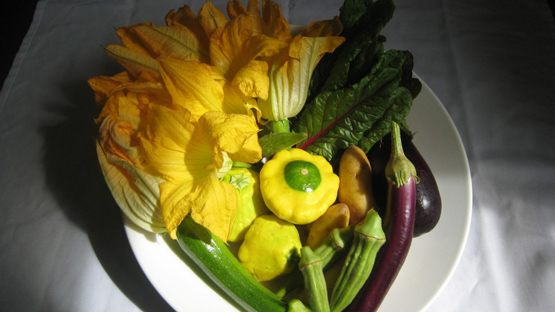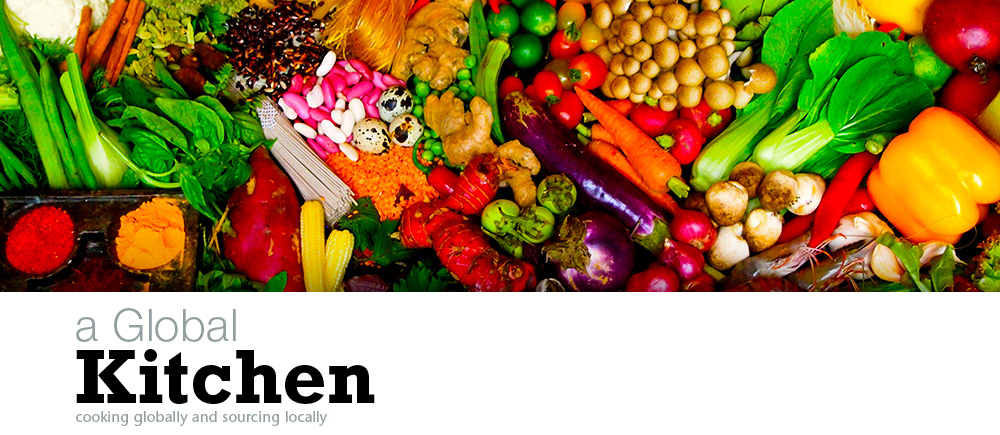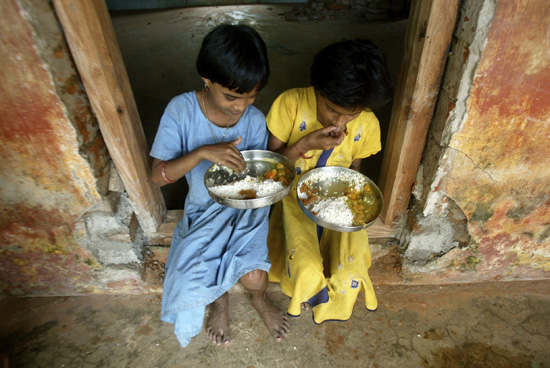In the fall of 2008 I travelled from Delhi to Turin, Italy to participate in Terra Madre, Slow Food’s conference that happens every few years and brings together food artisans, activists and many others concerned about safeguarding and promoting all aspects of food cultures from around the world. There I met some of the Slow Food Canada contingent, one of them being Lulu Cohen-Farnell of Real Food for Real Kids (check them out as they are doing great work with school lunches in Toronto). She told me about an article that she had recently read about a group of monks in India feeding schoolchildren in different states throughout India. Upon my return I found the article online and read that the foundation was called Akshaya Patra and it originated and was associated with the ISKCON temple in Bangalore. I was unable to visit any of their cooking centres until a few years later on a trip to the city of Puri, in the eastern state of Orissa. Here is an article, with a photo slideshow, I wrote about their school lunch program for the online website Zester Daily.
Tag Archives: Orissa
Zucchini Flower and Vegetable Fritters
 This past Sunday, during my weekly visit to the Landsdowne Farmer’s Market I spotted some bright yellow zucchini flowers and some perfect finger length okra from Acorn Creek Farms. Seeing these vegetables reminded me of my first trip, a year and a half ago, to Orissa, along the east coast of India. My friend, Jason, had introduced me to Debjeet from Living Farms– an organisation working to provide food sovereignty for the small and marginal farmers in India. Luckily, I connected with Debjeet in Bhubaneswar and he took me to a restaurant which specialized in Oriya food. We had a flavourful lunch of mustard coated fish and prawn curry (harvested from the brackish waters of nearby Chilka Lake) some fried okra spiced with panch phutana (cumin, mustard, fennel, fenugreek and kalonji) and a battered then fried pumpkin flower. I was pleasantly surprised to be served the pumpkin flower as I am aware of the seasonality of such a form of the vegetable. I am accustomed to preparing zucchini flowers in a French or Italian style but this was the first time I had seen it used in an Indian kitchen.
This past Sunday, during my weekly visit to the Landsdowne Farmer’s Market I spotted some bright yellow zucchini flowers and some perfect finger length okra from Acorn Creek Farms. Seeing these vegetables reminded me of my first trip, a year and a half ago, to Orissa, along the east coast of India. My friend, Jason, had introduced me to Debjeet from Living Farms– an organisation working to provide food sovereignty for the small and marginal farmers in India. Luckily, I connected with Debjeet in Bhubaneswar and he took me to a restaurant which specialized in Oriya food. We had a flavourful lunch of mustard coated fish and prawn curry (harvested from the brackish waters of nearby Chilka Lake) some fried okra spiced with panch phutana (cumin, mustard, fennel, fenugreek and kalonji) and a battered then fried pumpkin flower. I was pleasantly surprised to be served the pumpkin flower as I am aware of the seasonality of such a form of the vegetable. I am accustomed to preparing zucchini flowers in a French or Italian style but this was the first time I had seen it used in an Indian kitchen.
I’m not sure if you have the same problem but often I end up with little amounts of vegetables left in my fridge. This inevitably happens the day that I am to receive my CSA box and I need to find a way to use up the remnants from the previous week’s delivery. Tidying up to make room for the freshly harvested vegetables I found the forgotten okra and zucchini flowers (still in good shape as I had stored them in the butter compartment in the door). Instead of making a mixed vegetable pasta, soup or dal I decided to make a quick tea time snack using the neglected and leftover vegetables.
The recipe may appear lengthy but it is very easy. Consider it an Indian version of tempura, most often called bhaji or bhaja. Essentially, it is similar to a pakora but this time relatively thin slices of the vegetables are dipped into a chickpea and rice flour batter (crepe like consistency) and then fried until golden brown. It is best to make your accompanying chutney before you prepare the fritters.
- Batter Recipe
- ½ cup chickpea flour (you can use just chickpea flour but I find the rice flour adds a nice crispness to the fried batter)
- ½ cup rice flour
- ¼ tsp baking soda
- ½ tsp turmeric powder
- ½ tsp cayenne powder
- ¾ tsp salt
- 1 cup water
NOTE: This was originally posted on my blog India On My Plate on August 12, 2011


